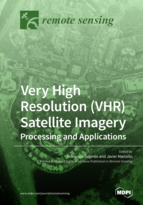Very High Resolution (VHR) Satellite Imagery: Processing and Applications
A special issue of Remote Sensing (ISSN 2072-4292). This special issue belongs to the section "Remote Sensing Image Processing".
Deadline for manuscript submissions: closed (1 February 2019) | Viewed by 83297
Special Issue Editors
Interests: multi/hyperspectral remote sensing; high resolution image preprocessing and analysis; change detection; multisensor registration; land and shallow waters applications
Interests: ecosystem monitoring; coastal areas assessment; multi/hyperspectral sensors; image fusion; classification and change detection
Special Issue Information
Dear Colleagues,
Optical sensors provide, nowadays, multispectral and panchromatic imagery at much finer spatial resolutions than in previous decades. Ikonos was the first commercial high-resolution satellite sensor, launched on September 24, 1999, breaking the one meter mark. Since then, Quickbird, Geoeye, Pleiades, Kompsat and many other very high resolution (VHR) satellites have been launched. Another important milestone was the launch in 2009 of WorldView-2, the first VHR satellite to provide eight spectral channels in the visible to near-infrared range. On the other hand, very high-resolution SAR finally became available in 2007 with the launch of the Italian Cosmo-Skymed and German TerraSAR-X, both providing X band imagery at a 1-m resolution.
In consequence, the recent advances in sensor technology and algorithm development enable the use of VHR remote sensing to quantitatively study the biophysical and biogeochemical processes in coastal and inland waters. Apart from water areas, VHR can be fundamental for the monitoring of complex land ecosystems for biodiversity conservation or precision agriculture for the management of soils, crops and pests.
In this context, recent very high-resolution satellite technologies and image processing algorithms present the opportunity to develop quantitative techniques that have the potential to improve upon traditional techniques in terms of cost, mapping fidelity, and objectivity. Typical applications include multi-temporal classification, recognition and tracking of specific patterns, multisensor data fusion, analysis of land/marine ecosystem processes and environment monitoring, etc.
This Special Issue aims at collecting new developments, methodologies and applications of very high-resolution satellite data for remote sensing. We welcome submissions which provide the community with the most recent advancements on all aspects of VHR satellite remote sensing, including but not limited to:
- Image preprocessing (pansharpening, atmospheric modeling, sunglint correction, feature extraction, etc.).
- Data fusion and integration of multiresolution and multiplatform data.
- Image segmentation and classification.
- Change detection and multi-temporal analysis.
- Vegetation monitoring in complex ecosystems.
- Precision agriculture.
- Urban mapping.
- Shallow waters seafloor mapping.
- Shallow waters bathymetry.
- Shallow waters water quality.
- Any use of very high-resolution satellite imagery related to remote sensing.
Dr. Javier Marcello
Guest Editors
Manuscript Submission Information
Manuscripts should be submitted online at www.mdpi.com by registering and logging in to this website. Once you are registered, click here to go to the submission form. Manuscripts can be submitted until the deadline. All submissions that pass pre-check are peer-reviewed. Accepted papers will be published continuously in the journal (as soon as accepted) and will be listed together on the special issue website. Research articles, review articles as well as short communications are invited. For planned papers, a title and short abstract (about 100 words) can be sent to the Editorial Office for announcement on this website.
Submitted manuscripts should not have been published previously, nor be under consideration for publication elsewhere (except conference proceedings papers). All manuscripts are thoroughly refereed through a single-blind peer-review process. A guide for authors and other relevant information for submission of manuscripts is available on the Instructions for Authors page. Remote Sensing is an international peer-reviewed open access semimonthly journal published by MDPI.
Please visit the Instructions for Authors page before submitting a manuscript. The Article Processing Charge (APC) for publication in this open access journal is 2700 CHF (Swiss Francs). Submitted papers should be well formatted and use good English. Authors may use MDPI's English editing service prior to publication or during author revisions.
Keywords
- Very High resolution multiplatform imagery.
- Atmospheric modeling and sunglint techniques
- Data fusion
- Segmentation and Classification
- Coastal applications
- Land applications







